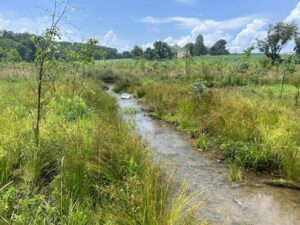Patuxent Mitigation Bank
Patuxent Mitigation Bank
Large scale stream and wetland restoration projects provide an opportunity to make substantial improvements in a watershed. The Patuxent Mitigation Bank is a stream and wetland restoration project located in Howard County, MD, to restore and preserve approximately 11,750 linear feet of Cabin Branch and create, enhance, or preserve 28.25 acres of adjacent floodplain wetlands. JMT developed this restoration project because the site’s high ecological uplift potential provided an opportunity to make significant and measurable improvements within the Patuxent watershed.
The objectives of the Patuxent Mitigation Bank were to restore habitats for a variety of species, enhance the cold-water fishery, plant native vegetation and pollinator habitats, and improve the floodplain by reducing the overall flood intensity, depth, and velocity of water. JMT developed these objectives and completed a functional assessment, collecting data over a three-year period to formulate a design for the site. Data collected included a geomorphic assessment, BANCS analysis, soil nutrient data, rain and stream gauge installation and data analysis, Stream Functional Pyramid evaluation, an existing wetland and waterways analysis, a forest stand delineation, a soils investigation, a full topographic survey, and a habitat assessment for the stream, its tributaries, and adjacent floodplain areas. JMT performed flow studies and monitored the fluctuation of water temperature within the stream at various locations. JMT also engaged a key subconsultant to perform MBSS fish and benthic surveys at multiple locations within the project limits.
While JMT believed the site had a high ecological restoration potential, it was not until the data were collected and analyzed that the actual site potential came to light. This site was classified as Use III-P Stream (Nontidal Cold Water and Public Water Supply), but there was no documentation of trout within the project limits. JMT’s data collection showed that the water temperature within Cabin Branch could sustain cold water species. The geomorphic survey and habitat assessment also identified one of the tributaries, the Shaffers Mill Road tributary, as having a 200’-300’ reach that was in very good condition. While the fish survey did not identify a high-quality fishery throughout the site, it did find a few trout of differing age classes within the 200’-300’ stretch of the Shaffers Mill tributary described above.
JMT coordinated with Maryland DNR Fisheries to use this information to develop a restoration design that preserves the high-quality tributary and creates the potential for an improved trout fishery throughout the rest of the site.







